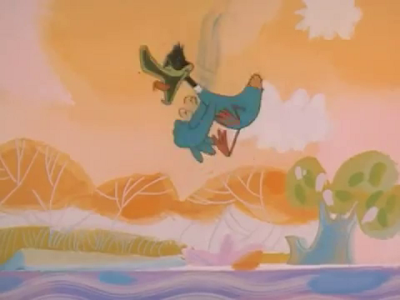This is post is thanks to reader Roger Niccum. Roger dug up an article on Ed Barge, one of the main animators of Tom and Jerry for many years, from the
Bakersfield Californian of April 11, 1944. Barge talks about making Tom and Jerry. The photo accompanied the original story.
SHARING BETWEEN THE SHEARS
By MAE SAUNDERS
Tom and Jerry are served up, not just at Christmas time, by Eddie Barge, artist and one of the chief animators in Movietone cartoons at Metro-Goldwyn-Mayer studio. Tom and Jerry are the artists pals every day when he picks up his brushes. Mr. Barge, who received preliminary art training in Bakersfield schools, began work in Hollywood a number of years ago as an artist who did much of the hack work that goes into putting together a motion picture cartoon. Now as one of the chief animators, he blocks in the main story scenes, meeting the requirements of the director. “Tom” and “Jerry” are his chief pals at M-G-M studio and there’s not a whisker that Tom and Jerry have between them that the artist hasn’t flicked impressively. In the motion picture cartoons, a little laugh is a big thing, artistically speaking. It’s the artist that really broadens the comedy with a line here and a line there.

Chief joy to the beholder in the Tom and Jerry cartoons, which by the way won the Academy award last year, is the theme of courage and resourcefulness of the little guy, the mouse, as pitted against brute force, the cat.
The making of motion picture cartoons is an art by itself requiring the co-ordination of many artists, timed perfectly to action and plot, blocked in colors, placement against background, and the final trimmings, all put to appropriate music.
There are approximately 50 or 60 sconces in an average cartoon. There are about four animators necessary to every picture. Artist crews can only turn out about six pictures a year.
Each drawing is “shot” twice; there are about 16 “frames” or 8 drawings to each foot and a half of film that is projected on the screen every second.
There are about 12 individual drawings every second on the screen. The average cartoon used to be about 800 feet, but it is now about 600 feet. This means an average of 6000 drawings per film.
The artist makes pencil sketches and these are run off by the director to test story strength. Sometimes drawings are changed to exaggerate action or subdue it.
The “personality” pictures with much facial expression are the most difficult to do, says the artist.
All the sound effects are marked carefully and the artist must make the sound and action synchronize in his work.
Many fine artists collaborate in making the cartoons, including voice experts, famous quartets and ventriloquists. Joke men and gag men work with directors on cartoon stories.
And, says the artist, it’s all done for the laugh.
Barge originally planned a career as a newspaper cartoonist, got his first job by walking into a Hollywood studio and showing them his drawings. Now he is getting regular screen credit for his work.
Edward John Barge was born on August 29, 1910 in Santa Clara, California to Alfred Edward and Margaret Gwendoline (Gannon) Barge. His father was an Englishman who worked for the Santa Fe Railway, settling in California around 1909 after living in Colorado. The family briefly moved to Kamloops, B.C., where Barge’s brother Al was born and his father is in the 1913 city directory as a brakeman for the Canadian Pacific Railway. But they were back in Bakersfield area by Christmas time 1916 as Barge and his older brother Henry played brownies in the Catholic parish’s children’s pageant (I suspect he never revealed this to his animation colleagues).
Barge’s name was typeset on the sports page of the
Californian a number of times. He played local baseball and basketball after graduating from school. In fact, he broke his leg in 1933 and a benefit baseball game was staged for him (the Depression was on, you know). The last I can find of Barge in the Bakersfield area is in July 1936.
He then headed to Los Angeles and got a job at the Harman-Ising studio before moving on to MGM; he was paid $1560 in 1939. In the ‘40s, he animated not only for Bill Hanna and Joe Barbera, but in the George Gordon and Lah-Blair units. Barge’s last cartoon for the studio was apparently “Feedin’ the Kiddie” (released in 1957). Barge wasn’t at the studio when it closed that year;
Broadcasting magazine of May 7, 1956 reported he, Morrie Zukor and Ron Maidenberg all left MGM to work for Animation, Inc. as an art director, assistant animator and story sketch artist, respectively. Barge was there into the 1960s. He later ended up working for his old bosses again on his old characters and other lesser Hanna-Barbera TV cartoons.
Barge died in Los Angeles on September 29, 1991.
.png)
.png)
.png)
.png)

.png)
.png)
.png)
.png)
.png)
.png)



































